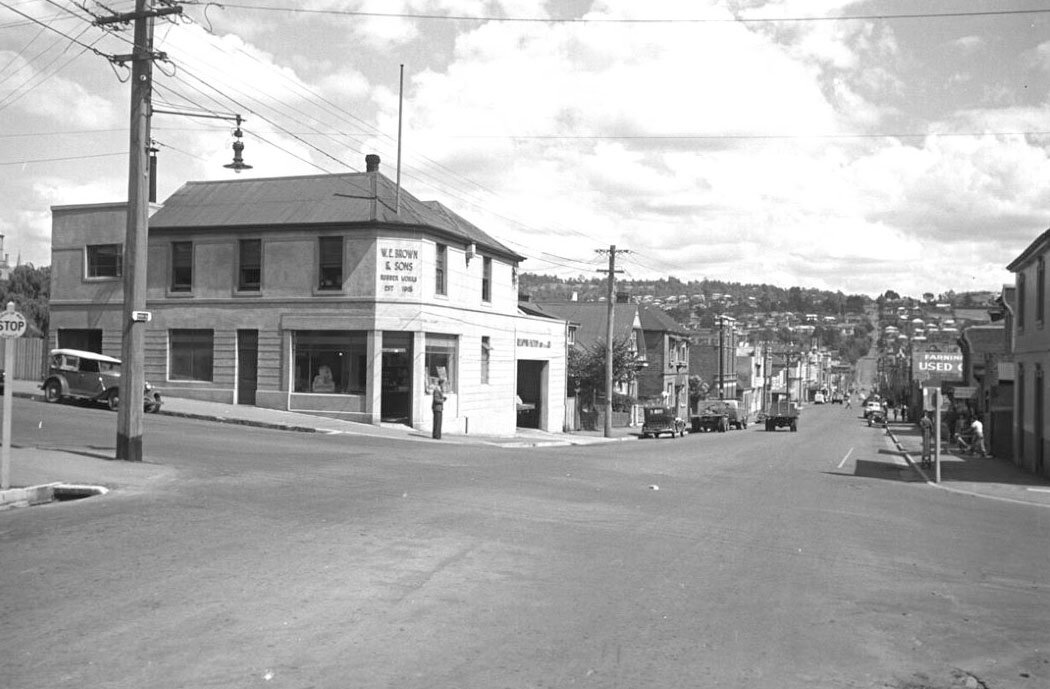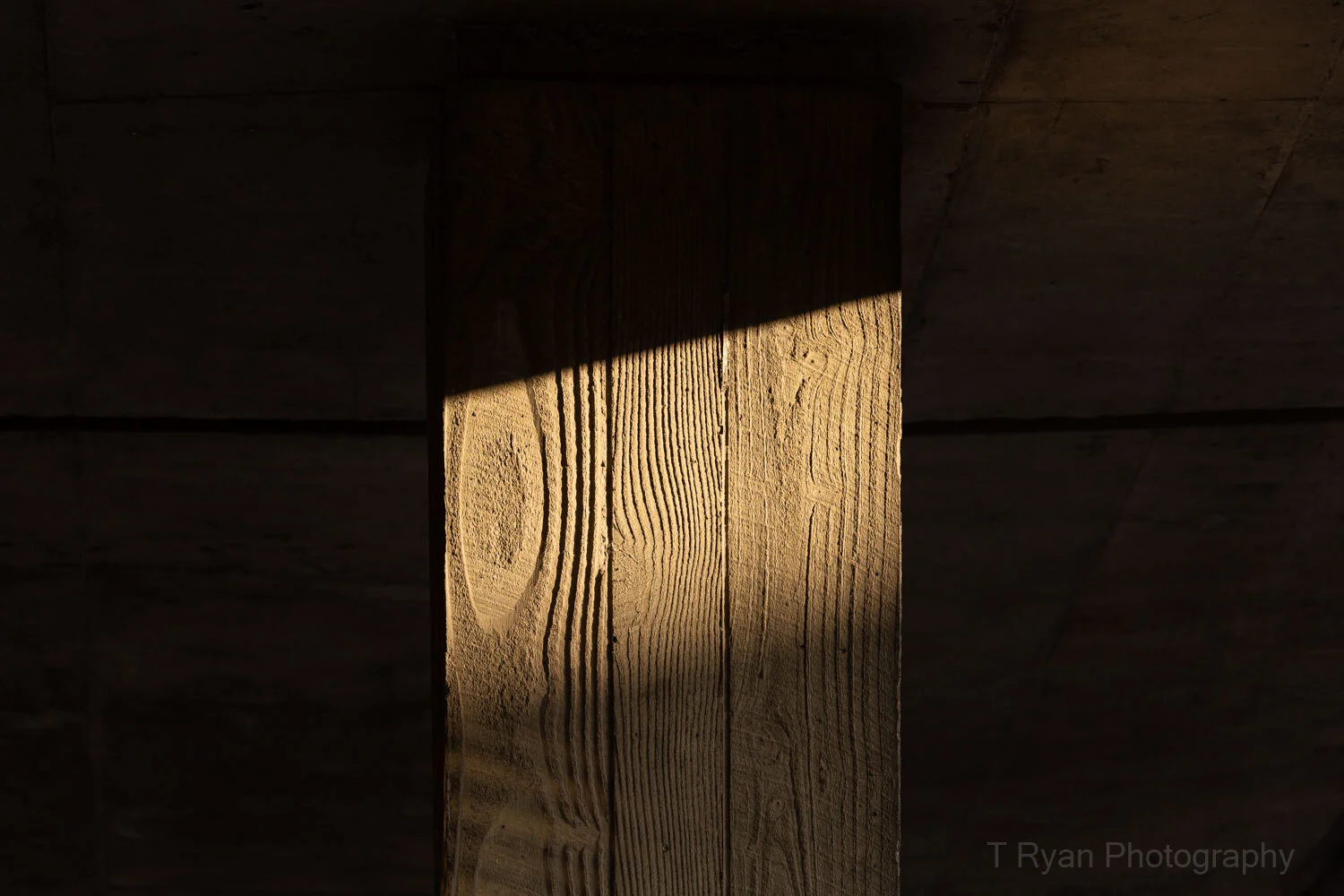1970s Launceston - Royal Automobile Club of Tasmania
This spectacular design is home to the RACT offices in Launceston. Designed in the 1970s it remains in excellent condition with little alterations to its original design. The staircase has recently been removed as some of the outbuildings that serviced vehicles and it had a a new paint job. There were tiles that featured under every windowpane which were covered over with sheeting. The design has fascinated me - its got Brutalist elements and feels space age futuristic.
RACT Offices in Launceston - An excellent 1970s design showcase
A photograph showing the building that stood prior to where RACT is now. I find it fascinating to view archive images and see what was there before. Also of interest is no street lights, just a humble stop sign to the far left on the footpath. Source - Queen Victoria Museum & Art Gallery
Henty House - Where Architecture meets Art
Henty House in Launceston is one of my favourite Modernist buildings in Tasmania. I enjoy its style and the photographic opportunities that it provides are countless. I find it such a photogenic building, its more akin to a piece of sculptural artwork. The textures, shapes and patterns from the concrete wood grain textures and how the light contrasts against shadow areas are a real joy and inspiration to capture on my camera. Over my 7 week road trip around Tasmania recently I focused on capturing new photos of Henty House. These are just some of the many details I captured of the sculptural beauty that is Henty House. Check out the new gallery on the website here for the entire ongoing project.
Tasmanian Modernism - New website photos & 1000 followers
With the situation we all face with lock-down comes time to work on my photography and updating my website. I have spent a good deal of time working on the Tasmanian 20th Century Modernism project. The Tasmanian Modernism Facebook group has been growing with participation from members sharing photos and thoughts. View the website and new photographs here
The Instagram page has just hit 1000 followers! Thank you so much for all of your support. It means a lot and helps me know people are interested in this important part of our heritage. I’ve provided a new layout for the project and added additional galleries such as the Brutalist Henty House Government offices and The former Woolsheds and Silos Launceston. I’ve added new photographs to the galleries too. I want to be able to share the “hero” photographs in the galleries, whilst at the same time not overpopulating each gallery to the point where things become a visual mess.
Henty House Government Offices - Launceston
I'm in a positive dilemma as I have over 10 years of photographs, literally thousands of photos in my archive. Working out what to share and leave out is a real challenge. For many photos that don’t feature in the galleries I will be sharing them on the blog. It’s been fulfilling process editing and remastering my photographs, especially in these strange times we find ourselves in. Spending 7 weeks at the start of 2020 making photos for this project is all the more special now considering the circumstances we are in now - it means I have plenty of photo editing to keep me busy. Check out the “new” and improved website here and let me know what you think and any suggestions you may have.
Documenting for Posterity - Today is Tomorrow’s History
*The term ‘Modernism’ throughout the article refers to the period of design occurring approximately between 1930-1980 in Tasmania. This period will be referred to as Modernism in the article.
Over the past decade the built landscape that is Tasmanian 20th Century Modernism has changed. Designs from this period have been altered beyond original recognition or demolished completely. Of course, there are many examples that remain and some that have been sympathetically renovated too. Going through my archives and of late being out in the field documenting Tasmanian Modernism I have witnessed dramatic changes to the built landscape, with only photographs as a visual reminder of what once was. Change is constant, and it motivates me to carry on documenting our built environment.
10 Murray Street Government Offices, Hobart. The offices opened in 1969 and were demolished in 2017/2018. In my period of time documenting Tasmanian Modernism a lot has changed. I spent over a decade photographing 10 Murray Street, documenting the entire process of its life. View the project gallery of 10 Murray Street here
The period of Modernism in Tasmania (especially the Post War years) witnessed a dramatic scale of building activity that has left Tasmania with a rich diversity of architecture from the Modernist period. This period cemented the very foundations of a confident and forward looking Island State, with the result that every corner of the island was affected in some way by Modernism. This era, and the late 1800s Victorian boom period, represent some of the greatest rates of change that's happened in Tasmania, and not witnessed on those scales since. During the Victorian period cities such as Launceston that were predominantly Georgian streetscapes were dramatically altered by demolition of many of these buildings for ostentatious Victorian architecture. Similarly some 50 years later these buildings were demolished for new Modernist designs, as well as alterations to existing buildings. This was a popular method of redevelopment whereby the older facades of buildings were demolished and newer designs attached. Especially during the interwar and post-war period, remodelling a building would have provided a cheaper way of modernising than demolishing and starting again. I find this kind of remodelling fascinating as it offers the chance to look at the layers of history, to see how a building has changed over the years, a kind of architectural archaeology.
Housing Department Estate, Risdon Vale Hobart - circa late 1950s/early 1960s. The period of Modernism in Tasmania witnessed a dramatic scale of building activity (especially State Government housing) leaving Tasmania with a rich diversity of architecture from the Modernist period. Photographic source: Tasmania Archive and Heritage Office
Fast forward to 2019 and Modernism isn't so young anymore. Art Deco architecture is now the elderly, edging ever closer to 100, whilst buildings from the 1970s are in their middle age - not having been around long enough to be looked back upon with nostalgia whilst not new enough to be considered relevant to today's needs. I guess it takes time for styles to gain an appreciation, or become fashionable and desirable. In the 1990s Art Deco wasn't admired as much as it is today, grand buildings were altered or demolished without a second thought. A decade ago, wood panelling and use of timber veneers were not popular, but the use of these materials is now a common sight and in vogue again today.
I enjoy the journey of documenting Tasmanian 20th Century Modernism through photography and research, but also enjoy the process of documenting contemporary architecture, the here and now as well as how cities, towns and the rural landscape of Tasmania is constantly changing. Photographs provide a portal into how a place and space looked at a particular point in time and, in doing so, represent trends/fashions/social norms of a time.
I like to think of myself as a documentary photographer for the built environment, preserving the past through photographs that hopefully convey a sense of feeling and emotion, more than just a snapshot. Transforming the seemingly everyday mundane into a powerful visual story. I also love capturing Modernism beyond the dramatic shots and exploring those more abstract photographic moments - such as how light and shadow interplay and interfuse with a subject, or how the use of materials evoke a sense of a bygone era.
Existing archive photographs photographs and the photographers who made it their life’s work to document the world around them provide visual reminders of the past, and how things have changed or been altered over time. I hope that I'll be able to look back on my photographs I've made knowing I've in some way contributed to preserving the built environment.
Suburbs in Tasmania developed rapidly after the War. With this housing boom came with it commercial businesses the sprung up. Corner stores, as pictured above, were a central part of the suburbs. The corner store is an example of how dramatically things have changed since the 1960s, with many having since been abandoned, redeveloped or demolished. Photographic source: Tasmania Archive and Heritage Office
I can’t bring a building back that's been demolished, but through photography I can freeze a point in time so that there is a record forever. Being out and about making photographs for the Tasmanian 20th Century Modernism Project offers great satisfaction and reinforces the realisation that we are but specs in time. The important thing for me as a photographer is to document this change so that there is a record of the past for posterity.
In future Tasmanian 20th Century blog posts I’ll be sharing photos and stories of the designs from this period that have been altered, or demolished.
Tasmanian 20th Century Modernism project website and social media:
Website www.tryanphotos.com/tasmanian-modernism
Facebook www.facebook.com/groups/tasmanianmodernism/
Instagram www.instagram.com/tasmanianmodernism











